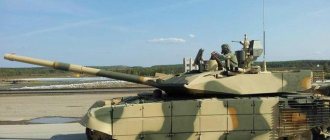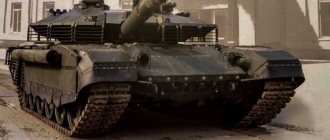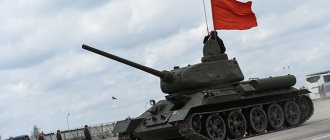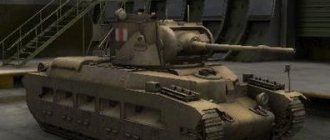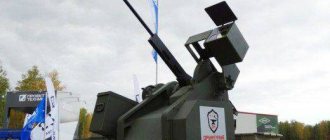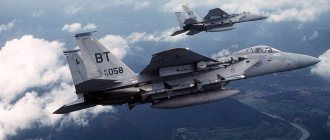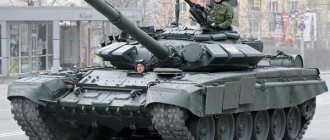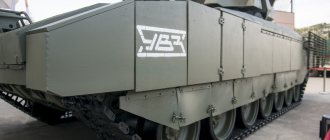152 mm gun for T-14: relevance and prospects
The concept of installing a 152 mm gun on a tank is not new; attempts to install this type of gun were made back in the mid-1980s, but technical difficulties, excess power and the crisis in the country did not allow such a task to be fully realized during Soviet times.
The promising T-14 tank on the Armata platform provides for the possibility of installing a 152 mm gun, but at the moment this tank has a modernized 125 mm gun. However, the Russian Ministry of Defense still intends to install a 152-mm gun on a limited number of T-14 tanks. Attempts to introduce the 152 mm gun on domestic tanks
The first tank with a 152 mm LP-83 cannon was the Leningrad Kirovsky "Object 292", created on the basis of the T-80BV tank. Due to financial difficulties in the late 1980s and early 1990s, only a single prototype of the tank was created in the fall of 1990. In 1991, tests began with test firing, during which a significant superiority of the 152 mm gun was revealed compared to the main tank gun with a caliber of 125 mm 2A46. In particular, this concerned the shot impulse being one and a half times greater with approximately equal recoil of the gun, which made it possible to install the gun on T-80BV tanks without significant modifications, significantly increasing their firepower.
However, in the 1990s, due to underfunding of the armed forces, “Object 292” did not pass all tests. In the future, the 152 mm LP-83 cannon was to be used on the Object 477 “Molot”, and its analogue, the 152 mm 2A83 cannon, on the Object 195 “Black Eagle”.
“Object 477” “Hammer” did not receive development due to the unfortunate location of the ammunition and was soon closed.
For the “Object 195” “Black Eagle”, a new 2A83 gun with a caliber of 152 mm was created at Yekaterinburg Plant No. 9, which is a modification of the 2A65 gun of the Msta-S self-propelled artillery mount (SAU). The first tests of the 2A83 gun took place on the B-4 tracked platform, where it showed the same high results as the LP-83. The direct shot range was 5100 m, armor penetration was 1024 mm of homogeneous steel, which exceeded the 2A46. However, in 2010, work on the Object 195 Black Eagle was stopped in favor of the new universal armored platform Armata.
Comparison of 125 mm and 152 mm guns
At the moment, T-14 Armata tanks have a modernized 125-mm 2A82-1M gun, developed by Plant No. 9 in Yekaterinburg.
Tactical and technical characteristics of the 125 mm 2A82-1M gun:
Gun type – smoothbore with chrome-plated barrel; Weight – 2700 kg; Barrel length – 7000 mm; The initial speed of the projectile is 2050 m/s; Effective firing range: – shells – 4700 m; – guided missile (URS) 3UBK21 “Sprinter” – 8000 m; – anti-tank guided missile (ATGM) “Reflex-M” – 5500 m; Rate of fire – 10–12 rounds per minute; Muzzle energy of the shot – 15–24 MJ; Armor penetration: – armor-piercing sabot projectile (APS) – 850–1000 mm; – ATGM – 950 mm; Gun barrel life: 800–900 shots; Ammunition - 45 shells; Automatic loader - 32 rounds.
The 2A83 gun, a modernized Msta-S 2A65 self-propelled gun, developed by the same Yekaterinburg plant No. 9, is being considered as a 152-mm cannon for the T-14 tank.
Tactical and technical characteristics of the 152 mm 2A83 gun:
Gun type – smoothbore with chrome-plated barrel; Weight – more than 5000 kg; Barrel length – 7200 mm; The initial speed of the projectile is 1980 m/s; Effective firing range: – shells – 5100 m; – URS “Krasnopol” 2K25 – 20,000 m; – URS “Krasnopol” ZOF38 – 12,000 m; Rate of fire – 10–15 rounds per minute; Muzzle energy of the shot – 20–25 MJ; Armor penetration: – BPS – 1024 mm; – ATGM – 1200–1400 m; Gun barrel life – 280 shots; Ammunition - 40 shells; Automatic loader - 24 rounds.
As can be seen from the characteristics of the guns, in comparison with the 2A82-1M cannon, the 2A83 cannon has significant superiority in almost all respects. It is also distinguished by the ability to fire ammunition up to 1 meter in length, such as the Krasnopol - previously they were used in the Msta-S self-propelled guns.
But this weapon also has a number of critical disadvantages, the main one of which is the significantly larger “parasitic mass” of the gun: even with the use of composite materials, the weight of the 2A83 is almost twice the weight of the 2A82-1M. This leads to the second disadvantage - a significant reduction in the tank's ammunition load. The third disadvantage of this weapon should be considered more than three times less service life of the gun barrel.
What do competitors have?
The main competitors of the domestic 2A83 gun are the German 130-mm Rheinmetall L55 gun. and a 140 mm American XM291 gun.
German L55 gun. 130 mm caliber is based on its 120 mm predecessor. Its exact characteristics are still unknown, in addition to the fact that the gun has a barrel length of 51 caliber (6630 mm), will have 50% more power compared to the 120 mm version, and the weight of the gun is 3000 kg. For firing from a 130-mm cannon, it is planned to use two types of promising unitary projectiles - an armor-piercing sabot projectile (APFSDS) with an elongated tungsten core, a partially combustible cartridge case using a charge on a new type of gunpowder; and a multi-purpose high-explosive fragmentation projectile with programmable air detonation, being developed on the basis of the DM11 projectile. Serial production of the gun is planned to begin by 2025.
The American XM291 140 mm cannon is the result of work on the ATAC (Advanced Tank Cannon) project. According to the developers, this gun has twice the power of the similar 120-mm M-256 gun mounted on M1A2 Abrams tanks. The gun has a removable barrel; the design of the breech allows the 140 mm barrel to be replaced with a 120 mm one, thereby allowing the use of both new types of ammunition and old ones. The gun has an automatic loader; during testing, the gun showed a rate of fire similar to that of the 2A83 - 12 rounds per minute. Ammunition capacity is 22 rounds of 140 mm caliber or 32–33 rounds of 120 mm caliber. The main disadvantage of this weapon is the very high recoil energy.
The gun has been in development since 1985 and has not yet been tested; to this day it is at the experimental stage.
Prospects for implementation and options for using the 2A83 gun on the T-14 tank
We can say quite confidently that a version of the T-14 tank with a 152 mm cannon will be created. Back in February 2016, the procedure for military acceptance of the T-14, including the version with a 152 mm gun, began. Rosatom specialists are already working on creating super-powerful explosive sub-caliber projectiles of 152 mm caliber from depleted uranium.
The problem of the small amount of ammunition for the 152 mm version of the tank can be solved by placing additional shells in the turret niche.
Since the T-14 has its own radar station, the 152 mm version of the tank proposes the use of Krasnopol-type guided projectiles. In this situation, the T-14 already resembles a self-propelled gun more than a tank, so it is possible that the 152-mm version of the T-14 in the documentation will have the abbreviation “combat artillery vehicle” (BAM).
From all of the above, we can conclude that the main weapon for the T-14 tank will remain the 125-mm 2A82-1M gun. A limited series of tanks will be produced with a 152 mm 2A83 caliber gun - to perform narrower tasks as part of a tank group. The scenario for using 152-mm guided projectiles is possible when destroying enemy fortifications, delivering high-precision strikes on enemy armored vehicles or air defense systems at a range of 20 km or more (the Krasnopol 2K25 projectile allows you to do this). Therefore, the T-14 tank with a 152-mm cannon will not be the main version of the tank on the Armata platform, but will serve as a highly specialized fire support vehicle.
Miracle weapon "Armata" - no use against scrap
It should be noted that the development of the 2A82 gun began in the early 1990s as part of the so-called “duplex” - two guns with different calibers, but similar in design. They planned to equip the promising Russian tank T-95 (Object 195) with a more powerful 2A83 cannon, which had a caliber of 152 mm, which the designers took up after the collapse of the Union and the freezing of the Kharkov project Object 477 “Hammer” with a similar weapon. And the second gun - 2A82, standard for the USSR tank caliber 125 mm, was intended for modernization of already built T-72 and T-80 tanks.
Promising Russian tank T-14 (Object 148) on the Armata platform
According to available data, the first prototype of the 125-mm 2A82 tank gun entered testing in 2003. To ensure high survivability, its barrel was made of high-strength steel (with increased requirements for metal quality), and the surface of the channel was chrome-plated. By the fall of 2006, tests in the amount of 787 rounds were carried out on a prototype 2A82; and on the next two prototypes - 613 and 554 shots, respectively.
In 2009, work on the Object 195 tank with a powerful 152 mm gun was closed, with the then Deputy Minister of Defense of Russia, General Popovkin, describing the project as “rooted in Soviet times” and “redundant.” After which the Nizhny Tagil UKBTM began to design a “lightweight” version of the promising Russian tank within the framework of the Armata design and development work, which later became known as the T-14 (“Product 148”).
Its main weapon was to be the 2A82 cannon. However, due to the fact that the new tank received an automatic loader of a completely different design than in the T-72/T-90, as well as an uninhabited fighting compartment, the gun had to be modified. In particular, it became possible to avoid purging the barrel after firing, which had a beneficial effect on the rate of fire. The gun, adapted for installation on the T-14, received the index 2A82-1M. Its characteristics are such that it is superior to the best NATO tank gun - Rh120 L/55 (caliber 120 mm, barrel length 55 calibers), used in the German Leopard 2 and the American Abrams. The muzzle energy of the Russian cannon is 1.17 times higher than that of the German one. All other characteristics were exceeded on average by 1.2−1.25 times. And the firing range reaches 7 km versus 5 km for NATO tanks.
Scale model of the 2A82-1M gun, Army 2017
The 2A82-1M cannon is capable of firing both all existing 125 mm ammunition and new promising ammunition. In particular, armor-piercing projectiles of increased power 3BM59 "Svinets-1" and 3BM60 "Svinets-2" with a length of 740 mm and new, specially designed for "Armata", armor-piercing projectiles "Vacuum-1" and "Vacuum-2" with a length 900 mm. So in the T-14 arsenal there are two more projectiles: a shrapnel fragmentation projectile with remote detonation at any point in the trajectory - “Telnik”, and a guided missile 3UBK21 “Sprinter”, which has an effective range of 8 kilometers.
Tactical and technical characteristics of the 125 mm gun 2A82-1M
Old Russian tank ammunition already had difficulty penetrating modern tank armor of such vehicles as the American M-1 Abrams or the Israeli Merkava - “... the 3BM-42 Mango has an outdated core design. There are two rather short tungsten rods inside the steel casing.”
In more modern projectiles - "Svinets-1" the core is made of tungsten carbide, and in "Svints-2" - from depleted uranium. Note that a core made of a material with a high specific gravity penetrates armor with greater efficiency. By the way, Svinets-2 is not the first Russian projectile with depleted uranium. The 3BM-32 Vant ammunition for the Soviet 125mm tank gun also used a depleted uranium core. “Vacuum-2” also has a rod made of depleted uranium with composite ceramic additives and a jacket made of low-melting material.
“Lead” rounds (armor-piercing sub-caliber projectile length 740 mm).
According to available data, the production of 2A82-1M guns began in early 2014, when the artillery Plant No. 9 purchased 7 forgings for barrels (mid-December 2013), and after some time another 6 pieces. This quantity coincides with the number of T-14 tanks produced up to 2015 inclusive. The first car was assembled in the pilot production of UKBTM - workshop No. 540, the remaining dozen - in workshop No. 130 of Uralvagonzavod. Apparently, these guns were used to equip them. Note that on May 9, 2015, only seven T-14 tanks passed through Red Square.
At the end of December 2022, Plant No. 9 purchased another 24 barrel blanks. These barrels are probably intended for the new T-14 tanks, which Russian Deputy Defense Minister General Krivoruchko spoke about at the Army-2018 forum: “As of today, a contract has been signed for 132 T-14 and T-15 vehicles. We will receive the first nine cars this year, production cars. The contract will be completed by the end of 2022.”
However, judging by the number of barrels for 2A82 guns, without which the Armata is not an Armata, we are talking about only 36 vehicles, which approximately corresponds to a battalion kit.
Based on materials from the blog “Gur Khan attacks!” and bmpd.
Found a typo? Select a fragment and press Ctrl+Enter.
Tags: Land equipment Armata Object 148 T-14 tank
Previous article The variability of the Hubble constant
Next article Finish line? Russia announced a solution to problems with T-14 Armata engines
Provided by SendPulse
Likes 0
“Made with us” and on Yandex.Zen
Modular, ultra-modern Armata is a unified platform and development program for heavy weapons of the Russian Army for the coming decades.
The sounds of the festive fireworks on May 9 on Red Square had not yet died down when the Armata platform began to reveal its planned potential.
T14 Armata + 152 mm
We have a shell that burns through a meter of steel, we will put it on Armata
,” Deputy Prime Minister Dmitry Rogozin, who is responsible for the military-industrial complex, told Izvestia.
But what kind of gun is this and what kind of projectile does Rogozin mean? In an interview with KP, Viktor Murakhovsky, a member of the expert council of the Board of the Military-Industrial Commission of the Russian Federation, answered this question as follows:
The gun already exists. It was developed as part of the development work on the T-95 tank. I can even name the brand of this gun - 2A83. It has successfully passed tests, including with new types of ammunition. In fact, this gun can penetrate more than a meter of steel.
The inventor of the new weapon was Artillery Plant No. 9 in Yekaterinburg, which is part of the Uralvagonzavod research and production corporation. And regarding shells, this is the Tekhmash corporation, which develops ammunition for tank, artillery and naval guns.
I attended a conference where the results of the development of new ammunition for a new tank gun on the topic “Stylus” were presented. They also showed photographs of the actual “work” of both armor-piercing sub-caliber and cumulative ammunition. Therefore, I can responsibly declare that the expression “more than a meter” corresponds to reality.
The 152 mm 2A83 super-cannon on the Armata today is already an “open secret.” Many experts foresaw this and consider the 2A83 tank gun to be the best in the world.
But everything is learned by comparison. What will we compare with? Of course, with the best NATO weapon.
2A83 vs Rh120 L55
The 120 mm long-barreled Rh120 L55 gun from Rheinmetall was considered the best production tank gun in the world. Currently it is installed on the newest Leopard 2A7+. To complete the picture, we will also compare the 2A83 with experimental guns: the American XM291 and the German NPz K-140. XM291 and K-140 are powerful 144 mm guns. The XM291 is bicaliber and fires both 144 mm and 125 mm projectiles.
For reference. During a firing demonstration in Abu Dhabi, a Krasnopol shell hit a moving tank from a distance of 12,000 meters. The maximum firing range of a Krasnopol high-explosive fragmentation projectile from a 155 mm cannon is 24,700 m, and an active-reactive projectile is 28,900 m.
29, 24, well, even 20 km! Imagine what a tank gun with such fantastic capabilities will do on the battlefield, and even together with a 100 km radar. By the way, about the radar and the potential of Armata. Why did the designers install such a powerful AFAR radar on the T14? Are they really planning to shoot as far as a hundred kilometers? ツ
Made by us
Impressive. But this potential is still not enough. KP military observer Viktor Baranets said literally the following in an interview with LifeNews:
And finally the main feature. T14 has a projectile that penetrates armor not only at 1 meter, but also gets close to 2 meters. Today there is no other tank in the world whose shell would be capable of such power.
Other competitors are MG253 and M256 guns
MG253 and M256 are installed on Merkavas and Abrams and are an analogue of the Rh120 gun. The M256 gun has an automatic loader with 44 rounds. AZ MG253 for Mk.4M with 10 rounds. The MG253 can also fire LAHAT ATGMs (armor penetration 800 mm) at a distance of 6000-8000 meters (according to other sources up to 8700 meters), and the M256 gun can fire MRM-KE kinetic projectiles at a maximum range of 12000 meters. The MRM-KE project has been frozen. As can be seen from the table, the potential capabilities of these guns are also worse than those of the 2A83 gun.
NATO will not soon have tanks like the Armata
Installing the 2A83 cannon on the T-14 will not require major tank upgrades. Military expert Viktor Murakhovsky explains:
The Armata platform is created as a unified and modular design. It provides for replacement, including the combat module with a cannon. The modules have the same electrical and information interfaces, data exchange protocols, etc. In the factory, you will simply need to dismantle one module with a 2A82 gun and replace it with another module with a 2A83 gun. Further, the new module easily interfaces with all tank systems without changing the layout or other components and assemblies.
NATO countries have already tried to create a gun similar to the 2A83. But the work was stopped. To even get close to the potential of the T14, the West will have to reconsider its entire tank building concept and start developing MBTs, essentially, from scratch. “I don’t think this is possible in the foreseeable period of time,” the expert believes.
Tanks with 152 mm caliber guns do not yet exist. All NATO tank projects with 144 mm guns are either closed or frozen, and so far all NATO products use a single caliber of 120 mm, while in China the Soviet caliber is 125 mm. The T14 Armata is also currently equipped with a 2A82 125-caliber cannon. However, even when equipped with a 125-mm 2A82 cannon and taking into account the capabilities of new shells for it, the T14’s characteristics are 20-30% higher than everything that is now in the West.
Well, if a gun of 152 mm caliber is installed, then we will be talking about superiority at times. There is nothing like this anywhere else in the world. And I am sure that this will determine the appearance of tank forces for the coming decades and will become a standard for all foreign tank builders,” Murakhovsky emphasized.
History of the creation of the 2A82 gun
Soviet engineers began developing the 125 mm 2A82 cannon back in the 90s. After all, the weapons of that time could no longer compete with Western developments. And the available tank ammunition could no longer cause significant damage to the new American Abrams or Israeli Merkavas.
As a result of the work carried out, two completely new guns were obtained. This is a powerful 152 mm 2A83 gun, which was planned to be equipped with the promising Russian T-95 tank. As well as the 125 mm 2A82 cannon, intended for the modernization of existing T-72 and T-80 tanks.
So, after careful modification, the 125 mm 2A82 gun was taken as the main weapon of the Armata. To increase survivability, its barrel is made of high-strength steel, and the channel surface is chrome-plated.
The T-14 designers were forced to temporarily abandon the 152 mm 2A83 gun. The reason for this decision was the reduced ammunition load compared to the 2A82 gun. However, if necessary, this most powerful weapon can be installed on the Russian T-14 Armata tank.
The expert commented on rumors about replacing the Armata with a tank with ETHP
Unsurpassed "Armata"
There have been talks for a long time that the T-14 Armata tank will receive another tank gun in the future.
At first it was planned to install a 152-mm 2A83 cannon on a promising combat vehicle. Compared to the standard 125-mm Armata 2A82-1M cannon, the 152-mm 2A83 cannon has significant superiority in almost all respects. Its shells are almost a meter long. The range of ammunition for the 2A83 may be expanded to include depleted uranium sub-caliber projectiles, which Rosatom specialists are working on. Previously, it was assumed that a limited series of T-14 tanks would be produced with a 152-mm 2A83 caliber gun - to perform narrower tasks as part of a tank group. However, this idea has not yet been implemented. However, having failed to achieve the practical implementation of this plan, the developers have already taken up a gun built on new physical principles - an electrothermochemical weapon. In ETHP, as reported by the media, the propellant is preheated and then fed under high pressure into the gun barrel, where it is converted into plasma using electrical energy. In this case, it is possible to obtain a smoother pressure curve in the barrel bore than in conventional guns and, as a result, increase the initial velocity of the projectile to almost 4500 meters per second. This is what it all looks like in theory.
Now we need to figure out where they plan to install all these guns. In other words, what is the promising Russian T-14 Armata tank like today?
Talk about some new generation of domestic tanks, while mass production of the T-14 has not even begun, it makes sense to consider it somewhat premature.
T-14 "Armata"
, is the newest Russian main battle tank with an uninhabited turret based on the unified tracked platform of the heavy category (by weight) “Armata”. The T-15 infantry fighting vehicle and the T-16 armored recovery vehicle were created on the same base.
The T-14 is the world's first tank of a fundamentally new layout with accommodation for a crew of three (commander, gunner-operator, driver) in a manned, protected, sealed compartment in the bow of the hull, separate from ammunition and fuel.
Before this, all tanks in the world had a so-called “classic” layout, where the crew was housed in the hull and turret along with ammunition and fuel tanks, which negatively affected its survivability on the battlefield.
For the first time, the tank is equipped with a unified on-board information and control system (BIUS) for armored vehicles. The key to the new system is the principle of network-centricity and open architecture. The main element of the electronic board is a digital information exchange network covering all units, components, complexes and subsystems. The network provides a standard interface for connecting subscribers to it. The role of subscribers is performed by electronic units built into functional units, assemblies, complexes and subsystems.
Noise in the media
“Before discussing only the hypothetical possibility of installing an electrothermochemical gun in the T-14 Armata (or this weapon in next-generation tanks), it seems advisable to look at the situation in the domestic tank forces a little more broadly,” he noted in a conversation with Gazeta.Ru editor-in-chief of the Arsenal of the Fatherland magazine, Colonel Viktor Murakhovsky.
The specialist pointed out the low level of awareness, and sometimes even competence, of domestic and foreign media in matters of the tank industry. Thus, he emphasized that there is now a wave of articles on the topic of the next “death” of tanks due to the alleged dominance of drones on the battlefield. Initiated, according to Murakhovsky, by publications in Western media.
In retaliation, other authors recalled an article in one of the Western sources, which expressed concern about the possible equipping of the promising T-14 Armata tank with a new 152 mm gun, superior to the current 125 mm tank gun.
“In this regard, they also mentioned supposedly “confidential” information about the development in Russia of a gun “on new physical principles” - an electrothermochemical one.
At the same time, there are so many factual errors and various kinds of speculation in publications on this topic that they can safely be classified as fantasy,”
- stated Viktor Murakhovsky.
“We will leave it to the conscience of foreign military personnel and publicists to determine their ideas about the future of tanks, their role and place in the weapons system. We ourselves would like to impartially understand the situation developing in domestic armored weapons and military equipment,” the specialist believes.
"Protracted birth process"
Such an attempt was made at the beginning of this decade. The formation of a new look for the Russian Armed Forces inevitably affected armored weapons and equipment (APT).
“The Ministry of Defense of the Russian Federation developed requirements for these weapons systems that meant a radical change in the development paradigm,” noted the editor-in-chief of the Arsenal of the Fatherland magazine.
The industry had to restructure itself in order to offer the army equipment that meets the current and future needs of the government customer.
In 2009-2010, inspection tests of all armored vehicles were carried out, based on the results of which the feasibility of their further use was determined. Then the military developed and adopted the concept of building a unified armored vehicle system for the period until 2022, defining requirements for the nomenclature of families and types of equipment, their combat and operational parameters.
The concept involves the so-called forced unification of armored vehicles with the gradual withdrawal of obsolete models from the Armed Forces. All previous development work (R&D) was curtailed, only three new ones were opened on the topics “Armata”, “Kurganets-25”, “Boomerang”.
A program was adopted to increase the military-technical level of existing equipment and maintain resources. The prospects for the existing armored vehicles have been determined: T-72/90, BMP-2, BMP-3 tanks - overhaul with modernization, T-80 and BMP-1 tanks - disposal after complete use of the resource.
Funds were also invested in creating a scientific and technical basis in certain areas: electric traction, electrothermochemical weapons, “digital board” and some others.
“The actual execution of the concept went poorly. The industry did not have time to develop promising models of armored vehicles and experienced significant financial difficulties due to the lack of orders for the supply of serial equipment,” stated Viktor Murakhovsky.
The government accommodated the defense industry enterprises halfway, and the concept of armored vehicles development actually lost the direction of forced unification. The creation of a scientific and technical basis has also slowed down.
“Not one of the promising armored vehicles has completed state tests, although to support the industry a contract was signed for the supply of 132 units of heavy armored vehicles of the Armata family. So rumors about the “death” of tanks in relation to their native fatherland are unfounded; rather, we can talk about a protracted process of birth,” concluded Viktor Murakhovsky.
